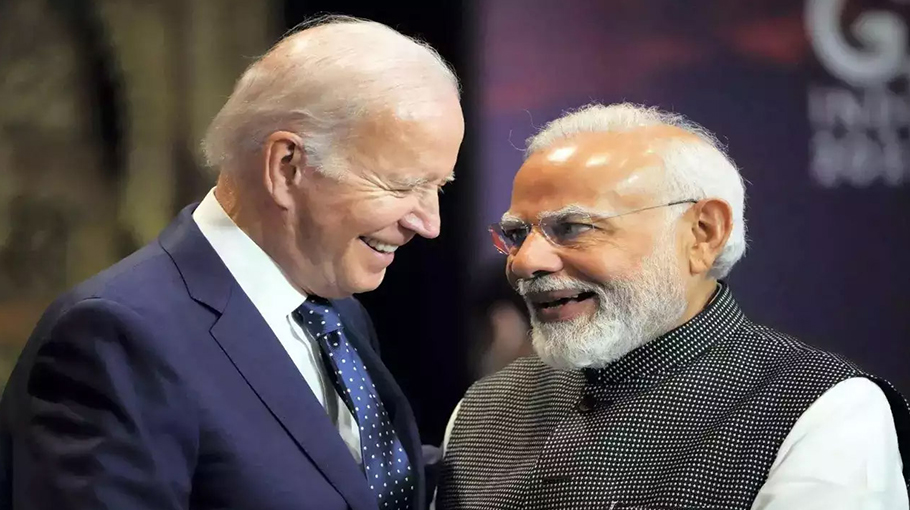Biden’s Outreach For: America First Top Priority For Biden

A country’s foreign policy is an extension of its supreme national interests. That old adage in the world of diplomacy was in full display as US President Joe Biden hosted Indian Prime Minister Narendra Modi at the White House on June 23 and rolled out the red carpet for him. What a contrast it was from 2002 when the US did not issue a visa to Modi in the wake of the riots in Gujarat when he was the state’s chief minister.
Fast forward to June 2023, it was Modi’s first state visit to the US and had all the trappings of the occasion befitting that: a state dinner by Biden and first lady Jill Biden and an address to the joint session of the US Congress, the last one being a rare honour given to only two other persons earlier—Nelson Mandela of South Africa and Winston Churchill of Britain.
The most significant takeaway from Modi’s visit was in the critical technology field relating to defence and space sectors: a mega deal between the US General Electric Aerospace and India’s state-owned Hindustan Aeronautics Limited for manufacture in India of GE’s F414 engine for the indigenous Light Combat Aircraft (LCA) Tejas Mk2. Besides, agreements on procuring drones from the US, a manned space mission to the moon and beyond and manufacturing semiconductors in India were among the big-ticket announcements. All of this clearly indicates that India and the US have left behind decades of technology denial era imposed by Washington in the wake of New Delhi’s testing of the nuclear device first in 1974 and then in 1998.
A section of Left-Liberals in India and a group of Democrat lawmakers in the US had hoped that Biden, during his closed-door talks with Modi at the White House, would do some tough-talking on alleged human rights violations, democracy deficit and treatment of minorities in India. There is no official word till the writing of this article if this indeed had happened. What the Left-Liberals in India and the Democrats had also hoped that Biden would go public, even if fleetingly, flagging the concerns over human rights and democracy in India.
However, the US President resisted that temptation. For him, the spin-off benefits from enhanced technology partnership, particularly in the defence sector, with India was uppermost and he did not want to spoil that. Biden has demonstrated that ideological moorings do not come in the way of furthering a country’s national interests.
For example, at the joint press conference where Biden and Modi replied to questions from one reporter from India and the US, the American President, when asked about raising issues of human rights and democracy with the Indian Prime Minister, said “Prime Minister and I had a good discussion about democratic values… and that is the best part of our relationship. We are straightforward with each other and we respect each other.”
“………it (democracy) is in America’s DNA and I believe in India’s DNA. And the whole world has a stake in our success, both of us in maintaining our democracies … makes us affiliate partners and enables us to expand democratic institutions across … the world,” he said. Biden drove home the point by contending the US-China relationship is not in the same space as with the US-India relationship because India and the US are democracies.” Clearly, Biden avoided publicly sermonizing Modi on the issue of purported deficit in free speech and dissent in India. The Biden dispensation did not sing along with Rahul Gandhi who, during his visit to the US (some days before Modi’s trip) repeatedly talked about the Modi government’s alleged assault on democracy in India.
On the other hand, the White House considered it as a diplomatic victory that Modi agreed to take two questions at the joint media appearance with Biden soon after their talks. That perhaps is understandable given the fact that the Indian PM, in his nine-year reign, has not taken a single question at his joint media appearances with foreign dignitaries at the Hyderabad House in New Delhi. Nor has he addressed a single press conference. Agreed that the media conferences at the White House are highly controlled and questions are put up well in advance, the fact remains that one question Modi was asked by an American journalist related to human rights, democratic values and treatment of minorities.
It remains to be seen if India-US cooperation in critical technology sustains in the time to come. It is the US tech denial regime that has prompted India to move closer to Russia for decades.
Given the Biden administration’s strained ties with both Russia and China, it has no option other than aligning with India. There seems to be finally a realization in the White House that India is the best bulwark against China. Ends
Pallab Bhattacharya is a senior journalist and columnist of India .




